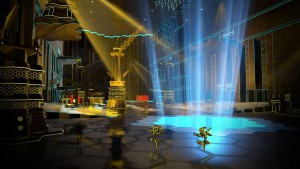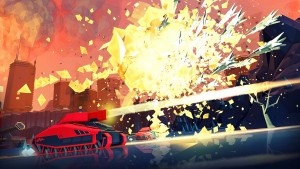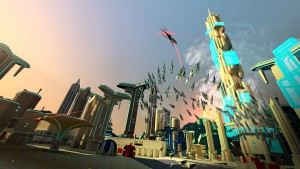Yesterday VRFocus reported on the news that Rebellion is planning to release some free DLC for their debut virtual reality (VR) title, Battlezone, after it has been released for the PlayStation VR head-mounted display (HMD). The videogame is a reboot of the original arcade shooter where the player controls their tank to destroy other tanks and machinery.
VRFocus sat down with the CEO and co-founder of Rebellion, Jason Kingsley, and in the interview below talks about the motivation behind making Battlezone a VR title, and how it has adapted elements from the original 80s arcade classic. He also shares about weaponry, potential for other HMDs, and how he considers himself a ‘VR tourist’.
VRFocus: Why make Battlezone VR?
Jason Kinglsey (JK): We first acquired Battlezone from an auction. We went to New York and there was an auction there in an enormous skyscraper, which was a very interesting experience in itself. My brother and I had always been very keen about Battlezone and felt that it was always one of the early titles in the arcade that dragged you into an alternate world and that as always part of the motivation for setting up Rebellion in the first place – creating worlds for people to experience. And the opportunity for VR came along and then it was pretty clear that there was a VR sort of version.
In fact, Battlezone original was kind of VR, we didn’t have the technology to move things around as efficiently as we do now, the process has massively improved in terms of speed. So I don’t know if you’re familiar with the arcade machine, there were two versions of it, and one of them you actually had to put your head up against it to look through some goggles, which I thought that was a very interesting idea, a very clever idea. So being able to revisit Battlezone in modern day VR is very, very exciting.
Also, interestingly, it was a stylised view. People say ‘it’s quite Tron-like isn’t it?’ And I go, ‘no, no. Tron is quite Battlezone-like’, because Battlezone pre-dated Tron by quite a long time. And obviously that kind of stylised computer look works well with getting high frame rates, and the key with VR is to get high frame rates to fool the eye, fool the human brain that the thing is real.
VRFocus: Was it your dream to make it a fully VR videogame?
JK: No, us getting Battlezone was really driven by passion for brand and it as an original as one of the first ever 3D computer games. We thought it was really cool, then VR came along and it became pretty clear to us that a VR version of it – a VR-led version of it, because we will be releasing a 2D version of it as well – would be a really good thing to look at. So in a way it was a bit of luck, a bit of good fortune, and it is an interesting opportunity. I’d like to claim that I was looking into a big VR game when we tracked down Battlezone and bought it. We knew VR was on the horizon but we didn’t know much about it in terms of when it was coming or anything like that. So a little bit of luck there I think.
VRFocus: How many elements did you use from the original version to make the VR one?
JK: We have made the game, as you’ll see from the demo, we’ve made the game solid. So it’s solid 3D but it’s still a kind of stylised cyber look. It’s a bit weird to make something look like computer graphics I suppose, because computer graphics is trying to get away from being computer graphics and is trying to do something different, rather to emulate the real world. And what we’re very thoroughly saying is no we don’t want to pretend to be the real world, we want to absolutely convince people they’re in a cyber world. Cyber itself is a bit of an old 80s 90s word to use, but at the same time that’s what we’re kind of going for, that vibe. So, a lot of nods to the original. We don’t currently have a wireframe mode, although we’re currently looking at that, but definitely built the aesthetics as strongly based on the original as we possibly can.
One of the components of the game is a strong nostalgia. I mean obviously you’re in a tank which is great for VR because moving around as a human being on foot is challenging to do well and no one has solved that as far as I’m aware. But trundling around in a tank, looking around the cockpit, works well intrinsically, so we don’t have to fight with– Three dimensional flight simulators, for example. Flying in real life makes people ill, people can get motion sickness really badly and not everyone can be a stunt pilot. So when you’re emulating that, you’ll emulate the motion sickness potentially there. When you’re in a tank or a car or something you’re sitting in, you’re doing the same thing as when you’re playing – you’re sitting and controlling your controller, it’s just that the landscape around you isn’t your computer, it’s something else. So it seemed to fit really nicely.
 VRFocus: How practical was it to design the different maps and landscapes using the neon aesthetic?
VRFocus: How practical was it to design the different maps and landscapes using the neon aesthetic?
JK: Well, we haven’t shown many yet publically but the demo we released is quite an old demo now, that’s what we’re publically releasing, but we have got a lot of varied elements to it so it isn’t all bright neon. We played around with that trope and that’s where we started and we wanted to emulate that. So really we are working very hard to make many varied landscapes in the game, but obviously they’ll be all very cyber Battlezone-esque style so we want to have a consistent computerised style throughout.
VRFocus: What can we expect with the weapon variety?
JK: Well that’s something we’re still working on as well. We want the game to have a lot of replayable value. There are a lot of VR demos out there, many really fun, but it’s sort of hard to see if there is any depth or longevity in them. Doing a tightrope walk is really interesting but how long do you want to spend doing that tightrope walk or a variety of different ones. They’re kind of really interesting snippets of entertainment. What we challenged ourselves to do, and what I think the team have done very, very well, is to make a proper game because a game is what you can play for hours and be able to replay as well. Replayablity is an important component of it. So we’re using the idea of computer generated components to its full – we haven’t announced what they are partly because we haven’t decided on what they’re going to be yet. We’re not being deliberately obscure, we just haven’t made those decisions yet.
We’ve obviously got the classic lobbing, the classic kind of arc is a key and a very satisfying component of the original Battlezone game. And when you shoot something that’s a long way away with that sort of arc it feels satisfying, you feel like you’ve done something quite skilful, so we’ve built on that kind of arc weapon and the idea of gravity being a certain way, so I’m hoping people get that kind of component as well, it’s quite an analog component for something that’s quite digital.
VRFocus: Have you had any difficulty trying to adapt the weapons to VR?
JK: Surprisingly it has worked very well, but we have had to turn down some of the special effects a bit because we found that they obscured your view too much, so we’ve kind of refined and improved what we’ve done in terms of the special effects. But broadly speaking the gameplay works well and weapons work well in VR. In fact, we’re working on a 2D version and we’ve had to modify it for people who can’t just spin around while trundling in one direction and looking sideways, because VR gives you that freedom, and we encourage people to look around during the game, and that encourages people to appreciate that they’re in a VR space.
Interestingly, the more experienced game players tend to lock their view forwards, and it’s only after a while they realise they can turn around. Whereas non-regular games players tend to look around like they would in the real world more. So there’s interesting ideas going on there.
 VRFocus: Is Battlezone aimed at single player or multiplayer?
VRFocus: Is Battlezone aimed at single player or multiplayer?
JK: We definitely have the single player component, but I don’t know what we’ve announced yet what we’re doing for multiplayer, but I’m very keen on multiplayer games in general, and Rebellion does a lot of multiplayer games, single player strong. We know that a lot of people like playing multiplayer, so two of our most successful titles recently – Sniper [Elite] has a head-to-head but also a co-op mode where two people can play the same game at the same time, and the same is with the Zombie Army Trilogy which is another one of our big successful games, where you can get a four player co-op mode. So we’re experienced when it comes down to the multiplayer co-op, but I’m not sure yet what we’ve announced when it comes down to the multiplayer in this game.
VRFocus: Have you considered using motion controllers?
JK: We have, and there’s a lot of them out there, they’re all very good. We’re just driving a tank so we decided to stick with the standard controller so it’ll be less of a challenge for people to get used to. And because we’re making a real game, we felt it actually made sense to use a real game controller as well. We didn’t really need to worry about that to begin with.
VRFocus: Are you still aiming to launch around the same time as PSVR?
JK: That’s right, yes. We are trying to come out at the same time as PlayStation VR, and if you ask me when that comes out, we don’t know. So we have the interesting experience of finishing off a game right now, but we don’t know when it’s going to hit the market, and we still don’t know, nobody does. So hopefully that’ll be announced sometime soon. We’re putting the finishing touches to our game hoping we’ll hit the right date – we don’t know what the date is yet though.
VRFocus: How long after are we to expect the Oculus Rift version?
We are doing a lot of work on DirectX 12, and it really depends on how well Oculus works on DirectX 12. We use our own engine, called Asura 3D engine, which we’ve done 3D stereoscopic in the early days. Again, you can play Sniper [Elite] and Zombie Army Trilogy on stereoscopic 3D TVs, so converting that for VR headsets wasn’t too difficult. We’ve got a pretty unique solution to the way we do the projections, and that’s quite exciting. Ours seem to be amongst the best in terms of peoples experiences. We’re not ruling anything out, but I think we’ll be first to launch on Sony’s VR.
VRFocus: Are you planning post-launch DLC?
JK: Yes, we’ve always done that for our games. If you’re going to ask me what they are yet I don’t know. We’re getting our plans together at the moment and we’re focusing very much on getting the first game out, and then once that’s in the box and everybody’s happy with that then we’ll move to DLC. What we do is we release free multiplayer content for our games, and then we do paid for kind of upgrades – cosmetic kind of upgrades, skins and costumes for the main character. For this game we’re not quite sure, it might all be free, it’d be rather nice to do that, or we might make some of it free. What we don’t like is to make people pay to win. Pay to brag is fine, pay to win isn’t.
VRFocus: Are there any plans for an HTC Vive version?
JK: Again, we have always been platform agnostic. Rebellion, from the earlier days, at one stage we were working on six different formats. The last Sniper came out on PC, PlayStation 3, PlayStation 4, Xbox 360, Xbox One, and I see no reason why any of our games shouldn’t be on as many platforms as possible, unless there’s a compelling business reason to keep it down to one. They’re all great systems, and they’ll all offer different challenges and different awards, so we’ll see. Unless there wasn’t any sensible market there for a headset, we would make the game for it if it made sense.
 VRFocus: Are you intending to make the 1998 remastered version VR as well?
VRFocus: Are you intending to make the 1998 remastered version VR as well?
JK: Ah, well that’s a tricky multi-layered question. The 1998 version, we have plans for that afoot, not been announced yet but there are things happening. If we then do a VR version of that, that’s an interesting one. Not currently in the immediate future, but we’ll see how VR goes. I’ve got high hopes for it and we’ll see if enough people like it, buying into the VR systems, then it’ll be successful for us. But at the moment… That’s an interesting idea.
VRFocus: Any other plans for Rebellion in VR?
JK: We’ve done some experiments in-house with some of our Zombie titles which was interesting, and it is fun to see post-apocalyptic, WWII landscapes in VR. How we make them into a game, I have no clue. But there’s a lot of interesting experiments going on, a lot of fun to be had by the dev teams.
We operate a portfolio on the games we do, and Battlezone is our play, if you like. It’s our experiment, our sort of go at VR. I’m confident that it will be very successful, and if it is successful we will be doing more VR. I can imagine a situation where we have 2D and 3D, VR and standard. I don’t know what the word is now, I’m going to have to think of a word for it – a kind of nonVR version of the game and a VR version of the same game, which hopefully with for our engine it will just be a game. If they have a VR system, they can play it VR, if they don’t have a VR system, they can play it 2D and enjoy it but if they get a VR system they can enjoy it in 3D. The only issue with that is that the gameplay sometimes will have to be different, so there may be some issues tweaking difficulty, tweaking speed, tweaking controls. It is a bit more difficult than what I’m saying now, but we don’t know.
VRFocus: What was your own experience when you played Battlezone VR?
JK: I really like being a VR tourist to be honest. I love playing games, don’t get me wrong, but I also like trundling around landscapes just admiring them. It’s just like visiting a castle or something and having a look round it – it’s a perfectly reasonable and sensible thing to do I think, and it’s the same with looking around what some of our art team have built. It’s fun to see those landscapes come alive really in a way that’s much more visual than before.
VRFocus: What aspect do you think you did really well for VR in this game?
The stuff under the hood really. The way we did VR projection is best of breed and I’m very proud of the team for what they’ve done, and I think pretty much everybody has said ours is the best they’ve seen, so giving it our best shot. And that’s nice because it’s British technology, its proprietary technology to us, and hopefully that puts us in a really strong position going forwards.
-END-
The post Rebellion CEO Talks HMD Releases, Aesthetics and More appeared first on VRFocus.















